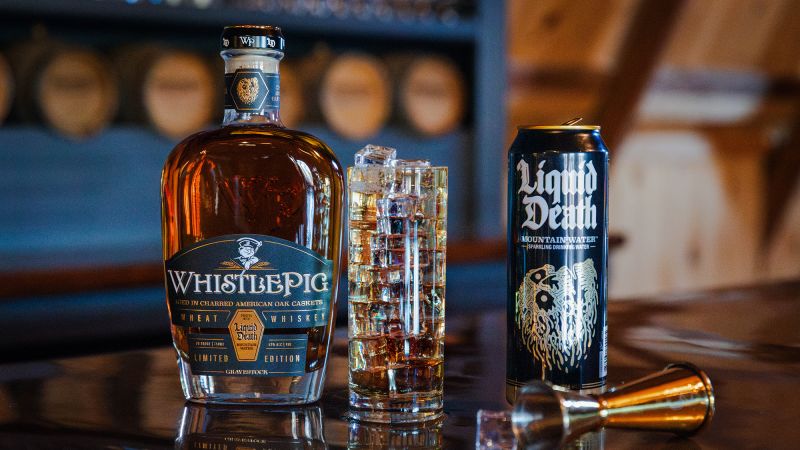Liquid Death, a trendy water brand, is taking steps to further align with its name by entering into the whiskey market. This development marks an exciting collaboration between Liquid Death and WhistlePig Whiskey, a well-known distiller based in Vermont. Their partnership will bring forth a new whiskey variety that is uniquely crafted, partially aged in a custom casket, and produced using Liquid Death’s mountain-sourced water. The announcement was made on Wednesday, revealing a creative fusion of hydration and spirits.
The limited-time offering is branded as “WhistlePig GraveStock Wheat Whiskey.” According to the companies, the whiskey aims to cater to enthusiasts who believe that life is too short to settle for anything less than the best. This collaboration is particularly noteworthy as it seeks to capture the attention of consumers who may have grown weary of more common alcoholic beverages, such as sparkling concoctions, canned drinks, and standard beers. The marketing strategy cleverly embraces a theme of indulgence while targeting a more discerning audience.
Interestingly, despite its morbid name, “WhistlePig GraveStock Wheat Whiskey” delivers an experience far from that concept. The whiskey itself has undergone several years of aging in a traditional oak barrel. Following this process, it was finished for approximately two weeks inside the custom-made casket, which, importantly, does not involve any actual corpses. The result is an impressive spirit with a robust profile; it boasts an 86-proof strength and features tasting notes that include honeysuckle, biscotti, and butterscotch.
The timing of this collaboration is advantageous for WhistlePig, particularly given the current climate in the spirits industry. Following a noticeable downturn in sales and recent layoffs that have affected major distilleries, WhistlePig Whiskey is characteristically approaching this challenge with innovative strategies. Charles Gibb, the newly appointed CEO of WhistlePig, who took the helm earlier this month after transitioning from the cocktail mixer company Fever-Tree, acknowledged the hurdles faced by the industry but highlighted growth opportunities for smaller brands like WhistlePig, particularly as consumers become more attentive to authentic products.
Gibb noted, “The industry’s having a tougher time than it’s had for a while.” He conveyed that despite current challenges, the situation may present an opening for brands such as WhistlePig, which have not yet achieved massive national scale but continue to resonate with consumers who value authenticity. This sentiment is particularly crucial as both WhistlePig and Liquid Death are relatively young brands within their respective markets. Their approach often incorporates bold partnerships, helping both companies stand out amidst competition.
Historically, WhistlePig Whiskey has made headlines through unique collaborations, having previously partnered with entities such as Formula 1 racing, rock legend Alice Cooper, and Solo Stoves for exclusive whiskey blends. Liquid Death, valued at approximately $1.4 billion, has similarly engaged in notable partnerships, collaborating with e.l.f. cosmetics and even Martha Stewart, in efforts to innovate and expand product lines.
The partnership entailed in “WhistlePig GraveStock” appears to fit seamlessly, as Gibb remarked that both brands have distinct followings. Their collaboration symbolizes a meeting of brand identities, merging to create something novel that not only intrigues consumers but also catapults both brands into new customer demographics.
In Gibb’s vision, partnerships like this one are effective mechanisms for attracting new consumers to the ultra-premium rye whiskey category, where WhistlePig stands as the top-selling brand. The “GraveStock” whiskey, in particular, is positioned as a lighter offering, suitable for warmer seasons and crafted to appeal to those who may be exploring WhistlePig for the first time.
The whiskey will be priced at $74.99 for a standard-sized 750ml bottle and is set for release on June 24, making it available online as well as through select retailers, restaurants, and bars. This endeavor not only embodies a spirited blend of creativity and market strategy but also highlights the ever-evolving landscape of beverage brands seeking to redefine their identities and connect with new consumer bases.



